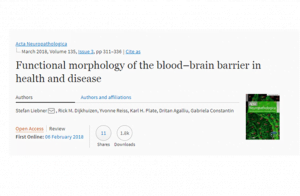 “Functional morphology of the blood–brain barrier in health and disease” has been published in Acta Neuropathologica. This work was supported in part by JPND through the SNOWBALL project, selected in the 2015 JPco-fuND call.
“Functional morphology of the blood–brain barrier in health and disease” has been published in Acta Neuropathologica. This work was supported in part by JPND through the SNOWBALL project, selected in the 2015 JPco-fuND call.
Yearly Archives: 2018
Doctors who work with individuals at risk of developing dementia have long suspected that patients who do not realize they experience memory problems are at greater risk of seeing their condition worsen in a short time frame, a suspicion that now has been confirmed in a new study.
Some brain conditions can interfere with a patient’s ability to understand they have a medical problem, a neurological disorder known as anosognosia often associated with Alzheimer’s disease. A study published in Neurology shows that individuals who experience this lack of awareness present a nearly threefold increase in likelihood of developing dementia within two years.
The researchers drew on data available through the Alzheimer’s Disease Neuroimaging Initiative (ADNI), a global research effort in which participating patients agree to complete a variety of imaging and clinical assessments. When a patient reported having no cognitive problems but the family member reported significant difficulties, he was considered to have poor awareness of illness.
Researchers then compared the poor awareness group to the ones showing no awareness problems and found that those suffering from anosognosia had impaired brain metabolic function and higher rates of amyloid deposition, a protein known to accumulate in the brains of Alzheimer’s disease patients.
A follow up two years later showed that patients who were unaware of their memory problems were more likely to have developed dementia, even when taking into account other factors like genetic risk, age, gender and education. The increased progression to dementia was mirrored by increased brain metabolic dysfunction in regions vulnerable to Alzheimer’s disease.
Article: “Anosognosia predicts default mode network hypometabolism and clinical progression to dementia”
Reprinted from materials provided by McGill University.
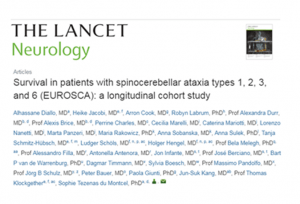 “Survival in patients with spinocerebellar ataxia types 1, 2, 3, and 6 (EUROSCA): a longitudinal cohort study” has been published in The Lancet Neurology. This work supported in part by JPND through the ESMI project, selected in the 2015 JPco-fuND call.
“Survival in patients with spinocerebellar ataxia types 1, 2, 3, and 6 (EUROSCA): a longitudinal cohort study” has been published in The Lancet Neurology. This work supported in part by JPND through the ESMI project, selected in the 2015 JPco-fuND call.
Amyloid beta pathology might have been transmitted by contaminated neurosurgical instruments, a new study published in Acta Neuropathologica suggests.
Researchers studied the medical records of four people who had brain bleeds caused by amyloid beta build-up in the blood vessels of the brain. They found that all four people had undergone neurosurgery two or three decades earlier as children or teenagers, raising the possibility that amyloid beta deposition may be transmissible through neurosurgical instruments in a similar way to prion proteins which are implicated in prion dementias such as Creutzfeldt-Jakob disease.
Amyloid beta is best known for being one of the hallmark proteins of Alzheimer’s disease, but the researchers did not find evidence of Alzheimer’s in this study.
A separate review of the medical literature supported the discovery by identifying four other case studies with similar pathology and past surgical history. As these patients were all men with a history of head trauma, research teams had previously speculated that those were correlated.
The new study suggests otherwise, as all patients had a history of childhood neurosurgery, three were women and only one had a history of head trauma.
In a comparison group of 50 people of similar ages from the same archives, the researchers did not find any amyloid beta pathology and only three had a recorded history of childhood neurosurgery.
Previous work in laboratory animals has shown that tiny amounts of abnormal amyloid beta protein can stick to steel wires and transmit pathology into the animals’ brains, but this paper is the first to suggest the same may be possible in humans.
Paper: “Evidence of amyloid-β cerebral amyloid angiopathy transmission through neurosurgery”
Reprinted from materials provided by UCL.
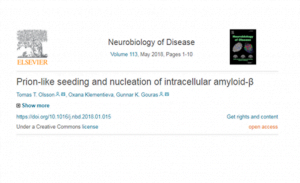 “Prion-like seeding and nucleation of intracellular amyloid-β” has been accepted for publication in Neurobiology of Disease. This work was supported in part by JPND through the DEMTEST project, selected in the 2011 biomarkers call.
“Prion-like seeding and nucleation of intracellular amyloid-β” has been accepted for publication in Neurobiology of Disease. This work was supported in part by JPND through the DEMTEST project, selected in the 2011 biomarkers call.
Researchers have found that excess levels of calcium in brain cells may lead to the formation of toxic clusters that are the hallmark of Parkinson’s disease. This is the first time it’s been shown that calcium influences the way alpha-synuclein behaves.
The study, published in Nature Communications, found that calcium can mediate the interaction between small membranous structures inside nerve endings, which are important for neuronal signalling in the brain, and alpha-synuclein, the protein associated with Parkinson’s disease. Excess levels of either calcium or alpha-synuclein may be what starts the chain reaction that leads to the death of brain cells.
Curiously, it hasn’t been clear until now what alpha-synuclein actually does in the cell: why it’s there and what it’s meant to do. Thanks to super-resolution microscopy techniques, it is now possible to look inside cells to observe the behaviour of alpha-synuclein. To do so, the researchers isolated synaptic vesicles, part of the nerve cells that store the neurotransmitters that send signals from one nerve cell to another.
In neurons, calcium plays a role in the release of neurotransmitters. The researchers observed that when calcium levels in the nerve cell increase, such as upon neuronal signalling, the alpha-synuclein binds to synaptic vesicles at multiple points causing the vesicles to come together. This may indicate that the normal role of alpha-synuclein is to help the chemical transmission of information across nerve cells.
Understanding the role of alpha-synuclein in physiological or pathological processes may aid in the development of new treatments for Parkinson’s disease. One possibility is that drug candidates developed to block calcium, for use in heart disease for instance, might also have potential against Parkinson’s disease, the researchers said.
Article: “C-terminal calcium binding of α-synuclein modulates synaptic vesicle interaction”
Reprinted from materials provided by Cambridge University.
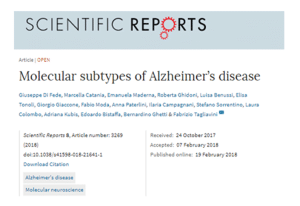 “Molecular subtypes of Alzheimer’s disease” has been published in Scientific Reports. This work was supported in part by JPND through the REfrAME project, selected in the 2015 JPco-fuND call.
“Molecular subtypes of Alzheimer’s disease” has been published in Scientific Reports. This work was supported in part by JPND through the REfrAME project, selected in the 2015 JPco-fuND call.
For couples with decades of shared memories, a partner’s decline in the ability to communicate is one of the most frightening and frustrating consequences of Alzheimer’s disease and related dementias. Impaired communication leads to misunderstandings, conflict, and isolation.
A new study published in the International Journal of Geriatric Psychiatry demonstrates how creative ways of working with these couples change their communication behaviors in just 10 weeks.
CARE (Caring About Relationships and Emotions) was designed to increase facilitative communication in the caregiver and sociable communication in the care receiver. The relationship-focused intervention also was designed to reduce disabling behavior (such as criticizing or quizzing their partner’s memory) in caregivers and unsociable behavior (such as not making eye contact) in care receivers.
A key finding from the study showed that care receivers actually improved more than the caregivers following the intervention. Care receivers, who had moderate dementia, demonstrated statistically significant improvements in their social communication both verbally and non-verbally. They were more interested and engaged, maintained eye contact, responded to questions, stayed on topic, and even joked with and teased their partners.
Caregivers’ communication also showed a statistically significant improvement in their facilitative communication and a statistically significant decrease in their disabling communication.
Paper: “Preliminary study of a communication intervention for family caregivers and spouses with dementia”
Reprinted from materials provided by Florida Atlantic University.
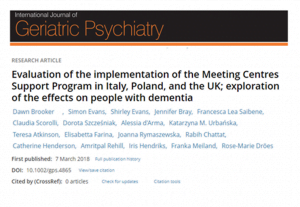 “Evaluation of the implementation of the Meeting Centres Support Program in Italy, Poland, and the UK; exploration of the effects on people with dementia” has been published in the International Journal of Geriatric Psychiatry. This work was supported by JPND through the MEETINGDEM project, selected in the 2012 healthcare evaluation call.
“Evaluation of the implementation of the Meeting Centres Support Program in Italy, Poland, and the UK; exploration of the effects on people with dementia” has been published in the International Journal of Geriatric Psychiatry. This work was supported by JPND through the MEETINGDEM project, selected in the 2012 healthcare evaluation call.
The selective demise of motor neurons is the hallmark of amyotrophic lateral sclerosis (ALS), also known as Lou Gehrig’s disease. Yet neurologists have suspected there are other types of brain cells involved in the progression of this disorder and perhaps also protection from it.
To get to the bottom of this question, researchers engineered mice in which the damage caused by a mutant human TDP-43 protein could be reversed by one type of brain immune cell. TDP-43 is a protein that misfolds and accumulates in the motor areas of the brains of ALS patients.
The study, published in Nature Neuroscience, found that microglia, the first and primary immune response cells in the brain and spinal cord, are essential for dealing with TDP-43-associated neuron death. It is the first study to demonstrate how healthy microglia respond to pathological TDP-43 in a living animal.
The number of microglia cells remained stable in mice with ALS symptoms. However, after the researchers chemically suppressed expression of pathological human TDP-43 in the mice, microglia dramatically proliferated and changed their shape and what genes they expressed.
The normally branched microglia retracted their extensions and expanded the size of their main cell bodies. The now abundant, remade microglia multiplied by 70 percent after one week and selectively cleared accumulated human TDP-43 from motor neurons. Microglia surrounded TDP-43-filled neurons and turned on genes to make proteins that helped them attach to the sick cells and induce a process called phagocytosis that envelops the mutant proteins for disposal. After the mop up, mice stopped exhibiting motor dysfunction symptoms such as leg clasping and tremors, and they regained their ability to walk and gain weight.
Paper: “Microglia-mediated recovery from ALS-relevant motor neuron degeneration in a mouse model of TDP-43 proteinopathy”
Reprinted from materials provided by the University of Pennsylvania.
